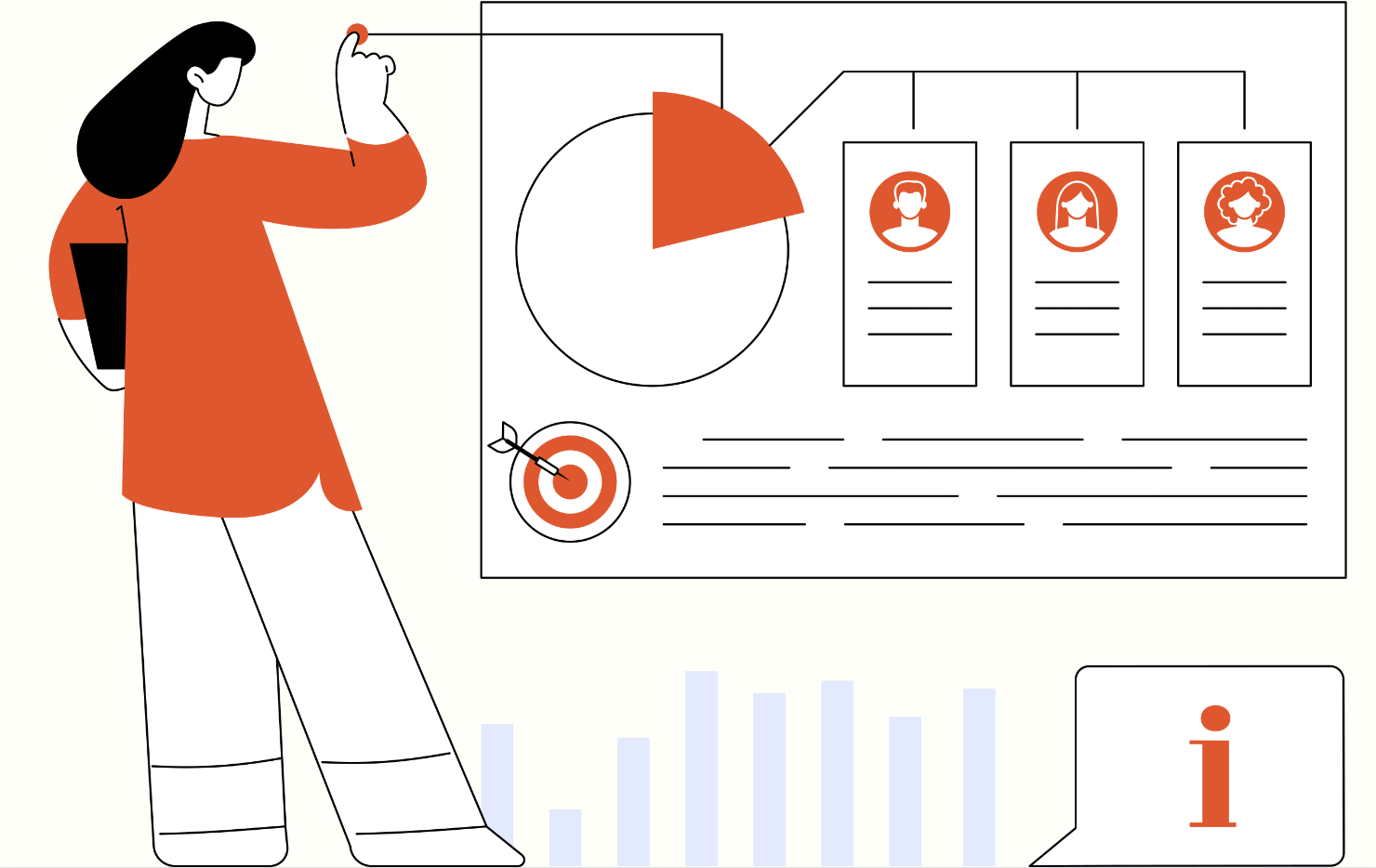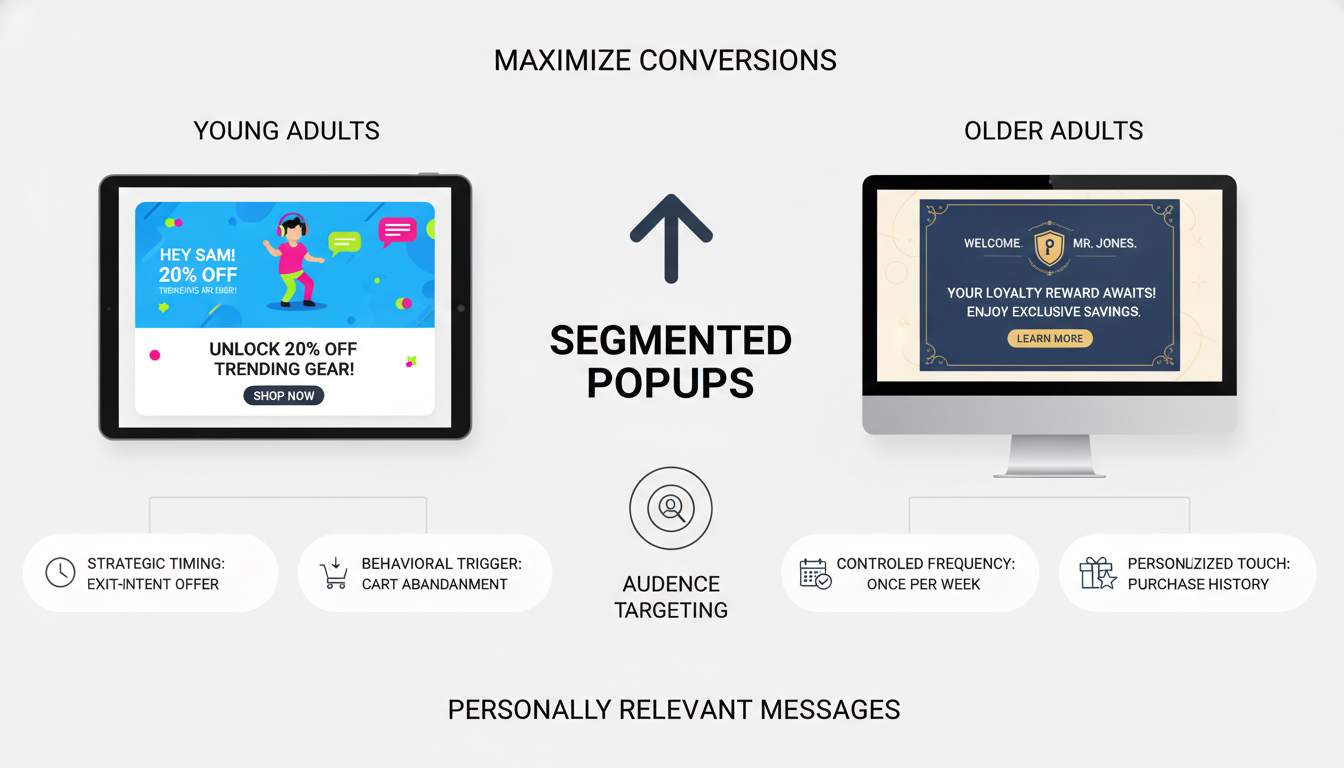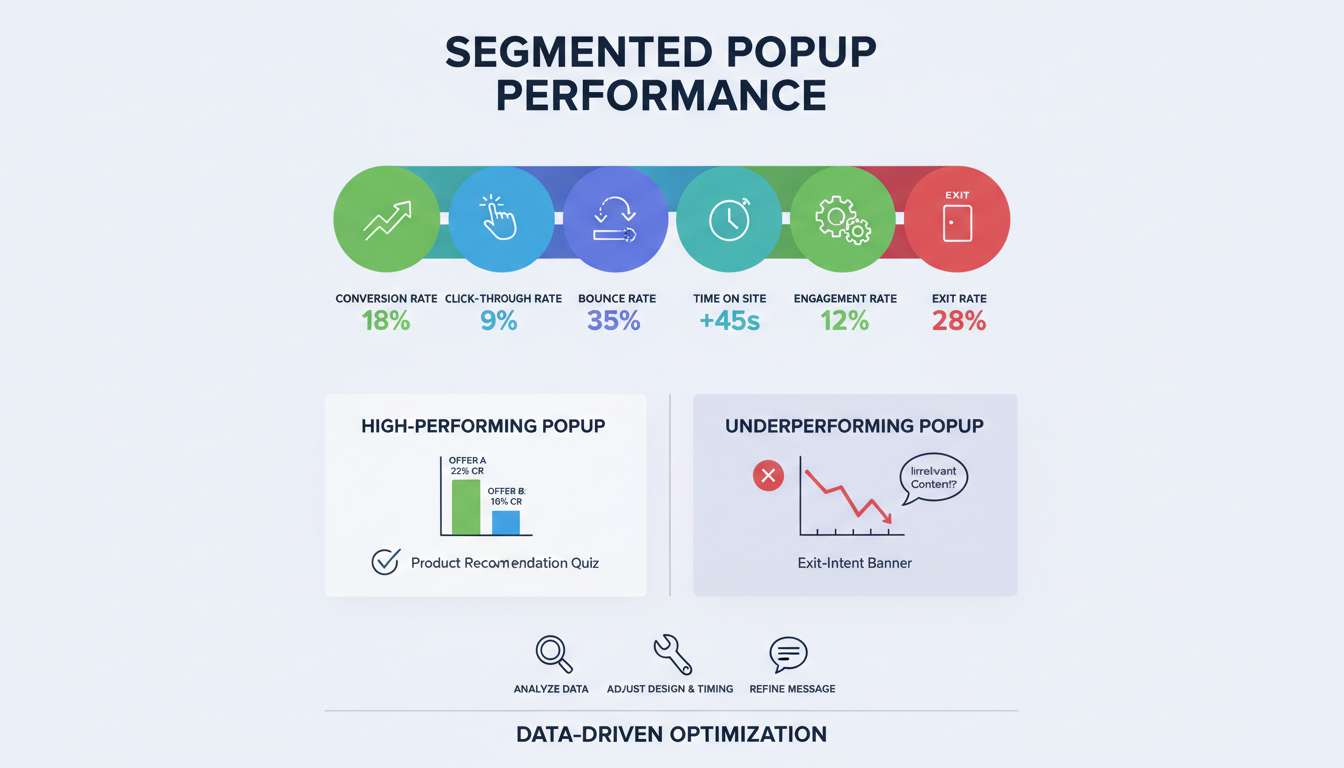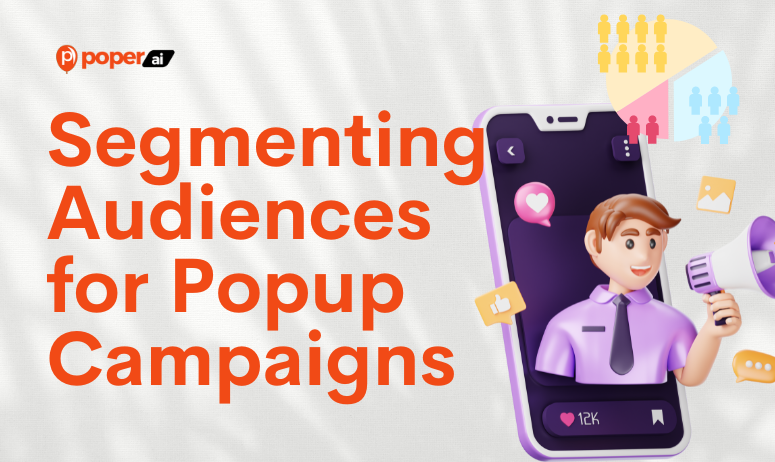The aim of marketing is to know and understand the customer so well the product or service fits him and sells itself.
Peter Drucker
In today's competitive digital landscape, understanding and catering to your audience's unique needs is more crucial than ever. Audience segmentation allows marketers to divide their audience into distinct groups based on specific criteria, enabling more personalized and effective marketing campaigns. This article explores the importance of audience segmentation in popup campaigns, providing insights into how it can significantly enhance engagement and conversion rates.
Audience segmentation is the process of dividing a broad target audience into smaller, more manageable groups based on shared characteristics. These characteristics can include demographics, behaviors, interests, and more. By segmenting audiences, marketers can tailor their messages to meet the specific needs and preferences of each group.
Understanding Audience Segmentation

What is Audience Segmentation?
Audience segmentation involves dividing a large audience into smaller groups that share common characteristics. This enables more precise targeting and personalized marketing strategies. Segmentation can be based on various factors, including demographics, geography, psychographics, and behaviors.
Benefits of Segmenting Audiences
Segmenting your audience offers several benefits:
Increased Engagement: Tailored messages are more likely to capture attention and engage users.
Higher Conversion Rates: Personalized marketing strategies lead to higher conversion rates.
Improved Customer Retention: Understanding and meeting customer needs helps build loyalty and retention.
Efficient Use of Resources: Focused marketing efforts ensure better use of resources and higher ROI.
Types of Audience Segmentation
There are several types of audience segmentation, each offering unique insights into your audience:
Geographic Segmentation: Based on location, language, climate, etc.
Psychographic Segmentation: Based on interests, values, lifestyle, personality, etc.
Behavioral Segmentation: Based on purchase behavior, browsing history, engagement level, customer loyalty, etc.
Key Factors for Segmenting Audiences

Geographic Segmentation
Geographic segmentation allows you to target audiences based on their location, ensuring relevance in your messaging.
Location: Targeting specific regions or countries.
Language: Customizing popups in the audience's preferred language.
Climate: Adjusting messages based on weather and seasonal changes.
Psychographic Segmentation
Psychographic segmentation delves deeper into the psychological aspects of your audience.
Interests: Aligning popups with user interests and hobbies.
Values: Resonating with the audience's core values and beliefs.
Lifestyle: Understanding and catering to different lifestyles.
Personality: Creating messages that appeal to various personality types.
Behavioral Segmentation
Behavioral segmentation focuses on user behaviors and interactions with your brand.
Purchase Behavior: Targeting based on past purchase history.
Browsing History: Customizing messages based on pages visited.
Engagement Level: Differentiating between highly engaged users and casual visitors.
Customer Loyalty: Rewarding loyal customers with exclusive offers.
Segmenting Audiences for Popup Campaigns
Importance of Targeted Popups
Targeted popups are more effective than generic ones because they address the specific needs and preferences of different audience segments. This leads to higher engagement and conversion rates.
Strategies for Effective Segmentation
To effectively segment your audience, consider the following strategies:
Combine Multiple Criteria: Use a mix of demographic, geographic, psychographic, and behavioral factors for more precise segmentation.
Regularly Update Segments: Keep your segments current by regularly updating them based on new data.
Leverage Technology: Use tools like Poper to automate and refine the segmentation process.
How to Segment Audiences Using Poper
Poper provides powerful segmentation features that allow you to create highly targeted popup campaigns. Here’s how to do it:
Define Segments: Use Poper to create segments based on demographics, behaviors, and other criteria.
Customize Popups: Design popups tailored to each segment, ensuring relevance and personalization.
Set Triggers: Configure triggers for each popup to display them at the right time and context.
Analyze Performance: Use Poper’s analytics to track the performance of segmented popups and make data-driven adjustments.
Creating Targeted Popup Campaigns

Designing Popups for Different Segments
Designing popups tailored to different audience segments is essential for maximizing engagement and conversions. Consider the following when creating segmented popups:
Visual Appeal: Ensure the design resonates with the specific segment. For instance, a popup targeting young adults might use vibrant colors and modern fonts, while one for older adults might opt for a more classic and straightforward design.
Content Relevance: Tailor the content to address the unique needs and interests of each segment. For example, a popup for new visitors could highlight an introductory offer, whereas a popup for returning customers might promote a loyalty discount.
Crafting Personalized Messages
Personalized messages can significantly increase the effectiveness of your popups. Tips for crafting personalized messages include:
Use Names: If possible, address users by their names to create a more personal connection.
Highlight Relevant Offers: Showcase products, services, or content that align with the user’s previous interactions or expressed interests.
Include Personal Touches: Add personalized touches, such as recommending products based on past purchases or suggesting content related to previously viewed articles.
Timing and Frequency of Popups
The timing and frequency of your popups are crucial to avoid annoying your visitors. Best practices include:
Strategic Timing: Display popups when users are most likely to engage, such as after spending a certain amount of time on the site or when they are about to leave (exit-intent popups).
Controlled Frequency: Limit the frequency of popups to prevent overwhelming users. For example, avoid showing the same popup multiple times during a single session.
Analyzing the Performance of Segmented Popups

Key Metrics to Track
To measure the success of your segmented popups, track the following key metrics:
Conversion Rate: Indicates how many users completed the desired action after seeing the popup.
Click-Through Rate (CTR): Shows the percentage of users who clicked on the popup.
Bounce Rate: Measures how many users left the site after seeing the popup.
Time on Site: Tracks how long users stay on your site after interacting with a popup.
Engagement Rate: Reflects the level of interaction with the popup, such as clicks and form submissions.
Exit Rate: Indicates how many users exited the site after viewing the popup.
Tools for Measuring Performance
Several tools can help you measure the performance of your popups:
Poper: Offers comprehensive analytics features to track key metrics and gain insights into popup performance.
Google Analytics: Can be integrated with your popup tool to provide detailed reports and analysis.
Hotjar: Offers heatmaps and session recordings to understand user interactions with your popups.
Interpreting Data and Making Adjustments
Regularly review the data collected from your popup campaigns to identify trends and areas for improvement. Steps for interpreting data and making adjustments include:
Identify High-Performing Popups: Look for popups with high conversion and engagement rates to understand what works well.
Recognize Underperforming Popups: Identify popups with low performance and analyze the possible reasons, such as poor design or irrelevant content.
Make Data-Driven Adjustments: Use the insights gained from your analysis to tweak and optimize your popups. This could involve changing the design, adjusting the timing, or refining the message.
Leveraging Poper for Audience Segmentation
Overview of Poper’s Segmentation Features
Poper provides a suite of powerful segmentation features to help you create targeted popup campaigns. Key features include:
Advanced Targeting Options: Segment your audience based on demographics, behaviors, and other criteria.
Personalization Tools: Customize popups with personalized messages and offers.
Trigger Settings: Set specific triggers to display popups at the right moments.
Integrating Poper with Your Website
Integrating Poper with your website is seamless and straightforward. Steps to integrate Poper include:
Install Poper: Add the Poper script to your website’s code.
Configure Settings: Set up your segmentation criteria and triggers within the Poper dashboard.
Design Popups: Create and customize popups using Poper’s intuitive editor.
Launch Campaigns: Activate your popup campaigns and start targeting segmented audiences.
Creating Segmented Popup Campaigns with Poper
Creating segmented popup campaigns with Poper is easy and efficient. Here’s how:
Define Your Segments: Use Poper to create audience segments based on various criteria.
Customize Your Popups: Design popups tailored to each segment, ensuring they are relevant and engaging.
Set Up Triggers: Configure triggers to display popups at the right time and context for each segment.
Monitor Performance: Use Poper’s analytics to track the performance of your segmented popup campaigns and make necessary adjustments.
Best Practices for Audience Segmentation in Popup Campaigns

Regularly Updating Segments
Regularly updating your audience segments ensures they remain accurate and relevant. As user behavior and demographics change, adjust your segments accordingly.
Combining Multiple Segmentation Criteria
Combining multiple segmentation criteria can provide a more comprehensive understanding of your audience. Use a mix of demographic, geographic, psychographic, and behavioral factors to create more precise segments.
Testing and Optimization
Testing and optimization are crucial for successful popup campaigns. Use A/B testing to experiment with different popup designs, messages, and triggers, and optimize based on performance data.
Staying Compliant with Privacy Regulations
Ensure your audience segmentation practices comply with privacy regulations such as GDPR and CCPA. Obtain user consent for data collection and clearly communicate your privacy policies.
Common Challenges and Solutions
Data Collection Issues
Data collection issues can hinder effective segmentation. Ensure you have robust data collection processes in place and use reliable tools to gather accurate data.
Segment Overlap
Segment overlap can dilute the effectiveness of your campaigns. Clearly define each segment to minimize overlap and ensure targeted messaging.
Changing User Behavior
Changing user behavior can impact your segmentation strategies. Regularly analyze user behavior data and adjust your segments accordingly to stay relevant.
Ensuring Data Privacy
Ensuring data privacy is critical for maintaining user trust. Implement strict data privacy measures and adhere to legal requirements to protect user information.
FAQs
What is the best way to segment my audience for popup campaigns?
The best way to segment your audience is by using a combination of demographic, geographic, psychographic, and behavioral criteria to create precise and relevant segments.
How can I use Poper to segment my audience?
Poper offers advanced segmentation features that allow you to define segments, customize popups, and set triggers for targeted campaigns. Use Poper’s intuitive dashboard to manage and optimize your segments.
What metrics should I track for segmented popups?
Key metrics to track include conversion rate, click-through rate (CTR), bounce rate, time on site, engagement rate, and exit rate.
How often should I update my audience segments?
Regularly update your audience segments to ensure they remain accurate and relevant. Monitor changes in user behavior and demographics to adjust your segments accordingly.
Are there any legal considerations for audience segmentation?
Ensure your segmentation practices comply with privacy regulations such as GDPR and CCPA. Obtain user consent for data collection and clearly communicate your privacy policies.
Summary
In this article, we explored the importance of audience segmentation in popup campaigns, the types of segmentation, and the benefits of targeting specific audience segments. We also discussed how to use Poper for effective segmentation and provided best practices for optimizing your campaigns.
Audience segmentation is a powerful tool for creating personalized and effective popup campaigns. By understanding and targeting your audience’s unique needs and preferences, you can significantly improve engagement and conversion rates. Leverage tools like Poper to streamline the segmentation process and enhance your digital marketing strategy.




